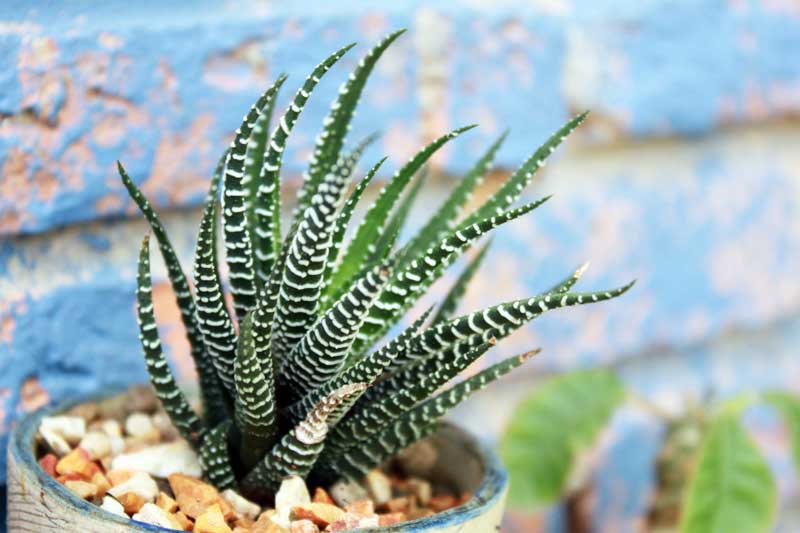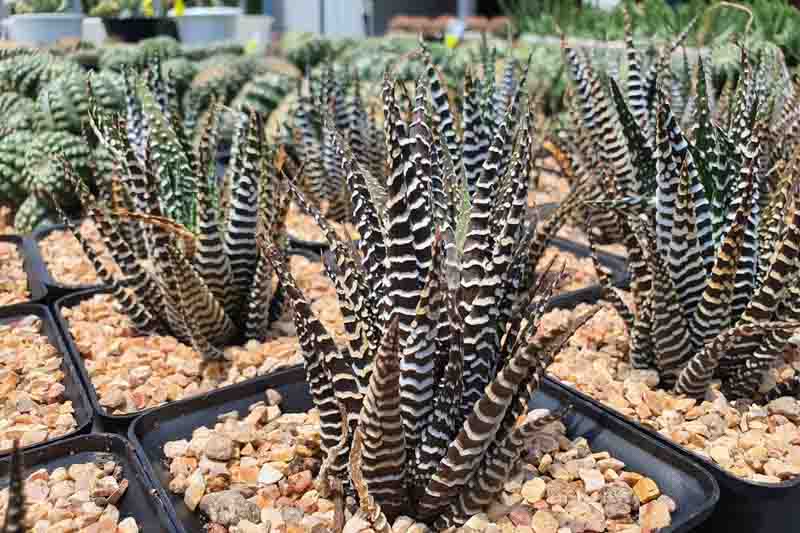Zebra Haworthia, Zebra Plant, Haworthia attenuata
Haworthiopsis attenuata, often mistaken for its close relative Haworthiopsis fasciata due to their similar appearance, is a charming and resilient succulent that brings a touch of nature’s marvel to homes and gardens. Its unique features and low maintenance requirements make it a favored choice among plant enthusiasts.
Zebra Haworthia features rosettes of pointed, dark green leaves adorned with white, bumpy stripes or tubercles on the underside and sometimes along the upper surfaces. These stripes help differentiate it from H. fasciata, which typically has them only on the underside. The plant’s leaves grow outward from the center of the rosette, creating a striking, star-like pattern.
Native: This succulent is native to the Eastern Cape Province of South Africa, where it thrives in partial shade under bushes and rocks, adapting to its environment with remarkable resilience. Zebra Haworthia belongs to the Asphodelaceae family along with Aloe, Eremurus (Foxtail Lily), and Hemerocallis (Daylily).
Plant Type and Habit: Zebra Haworthia is a perennial succulent that forms compact rosettes. It has a clumping habit, often producing offsets that can form dense clusters over time. This growth pattern allows it to spread outwards, creating a carpet of rosettes in its natural habitat and in cultivation.
Size: The plant remains relatively small, making it an excellent choice for those with limited space. Mature rosettes typically reach about 8-12 inches (20-30 cm) in height and can spread to around 12 inches (30 cm) wide.
Flowers: Zebra Haworthia produces slender, pale to dark pink or white flowers on long, thin stems that extend well beyond the foliage. The flowers are small and tubular and bloom in clusters from late spring to early summer.
Foliage: The most notable feature is the foliage, with its pointed, dark green leaves adorned with horizontal white stripes or tubercles. These markings not only contribute to the plant’s aesthetic appeal but also enhance its texture.
Hardiness: This succulent is hardy in USDA zones 9 to 11. While it can tolerate brief cold periods, it is not frost-tolerant and should be protected from temperatures below freezing.
Uses: Zebra Haworthia is primarily grown as an ornamental plant. It is ideal for container gardening, rock gardens, and terrariums. Its small size and unique appearance make it a popular choice for desk plants, windowsills, and succulent arrangements.
Toxicity: Zebra Haworthia is generally considered non-toxic to pets and humans, making it a safe choice for households with animals.
Drought: Like most succulents, Zebra Haworthia is highly drought-tolerant once established, requiring minimal watering.
Invasiveness: This plant is not invasive and is well-contained within its growing area, making it a responsible choice for gardens and indoor settings.
Benefits: Its water-wise nature aligns with eco-friendly gardening practices, and its ease of care makes it a fantastic plant for beginners.

Growing and caring for Zebra Haworthia, both indoors and outdoors, requires attention to a few specific conditions to ensure its thriving growth and the maintenance of its distinctive striped leaves.
Light: Position in bright, indirect sunlight. An east or west-facing window is perfect, as direct midday sun can scorch the leaves.
Water: Allow the soil to dry completely between waterings. Water sparingly, especially in winter, to avoid root rot.
Soil: Use a well-draining cactus or succulent mix to ensure excess water can escape.
Temperature: Keep at a comfortable room temperature, between 60°F to 80°F (15°C – 27°C). Avoid exposure to cold drafts and temperatures below 50°F (10°C).
Humidity: Average home humidity levels are adequate.
Feeding: Feed with a diluted succulent fertilizer once in spring and once in summer.
Repotting: Repot every 2-3 years in spring to refresh the soil. Choose a pot just slightly larger than the current one with good drainage.
Light: Plant in a spot that receives partial shade or filtered sunlight. If the plant receives too much sunlight, it will turn a deep red, showing it is stressed, or turn white and dry up.
Soil: In garden beds, ensure the soil is well-draining. Amend with sand or gravel if necessary.
Water: Outdoor plants may require more frequent watering than indoor ones, especially in hot, dry conditions. Still, let the soil dry out between waterings.
Temperature: Zebra Haworthia can be grown outdoors year-round in USDA zones 9 to 11. In cooler climates, it should be brought indoors before the first frost.

Propagating Zebra Haworthia is a straightforward process that can be done through offsets, leaf cuttings, or seeds, with offsets being the most common and easiest method.
Wait for Offsets: Zebra Haworthia produce small offsets or pups around the base of the mother plant. Wait until these pups are a reasonable size (at least an inch wide) before separating them for a higher success rate.
Separate Offsets: Carefully remove the soil around the base of the mother plant to expose the offsets. Using a clean, sharp knife or scissors, cut the offsets away from the parent plant, ensuring each has some roots attached.
Let Offsets Dry: Place the offsets in a warm, dry location out of direct sunlight for a few days to allow the cut surfaces to callous over. This helps prevent rot when planted.
Plant Offsets: Plant the calloused offsets in a well-draining succulent soil mix. Use small pots with drainage holes to prevent water retention.
Water Sparingly: Water the newly potted offsets lightly to encourage root growth. Wait until the soil is completely dry before watering again.
Choose a Healthy Leaf: Select a healthy, full-grown leaf from the Zebra Haworthia.
Detach with Care: Gently twist the leaf from the stem, ensuring you get a clean break. It’s crucial to get the entire leaf, including the base, for successful propagation.
Dry the Leaf: Allow the leaf to dry for a few days until the cut end callouses over.
Plant the Leaf: Place the calloused end into a well-draining succulent mix, just enough to hold it upright.
Wait for Growth: Keep the soil slightly moist and in bright, indirect light. Roots and a new plant should emerge in a few weeks to months.
Sow Seeds: Sow Zebra Haworthia seeds in a well-draining soil mix and lightly cover with soil. Keep moist and in a warm place with indirect light.
Germination: Seeds can take weeks to months to germinate. Keep the soil consistently moist but not waterlogged.
Regardless of the method, propagation success requires patience. Newly propagated plants may take some time to establish themselves and grow into mature, healthy plants.
Zebra Haworthia is generally easy to care for, but like all plants, it can encounter pests, diseases, and common problems.
Mealybugs: These tiny, white, cottony pests tend to hide in the crevices of the plant, sucking sap and weakening it. Treat by dabbing the pests with a cotton swab dipped in rubbing alcohol or applying neem oil.
Root rot: Overwatering is a common cause of root rot in Zebra Haworthias, leading to mushy, brown roots and bases. Prevent this by ensuring well-draining soil and pot and watering only when the soil is dry.
Leaf Spot and Fungal Diseases: These can occur in overly moist conditions or when water is left on the leaves. Prevent by watering the soil directly, avoiding the leaves, and ensuring good air circulation around the plant.
Brown Tips on Leaves: Often a sign of underwatering or low humidity. Ensure the plant is watered correctly and consider increasing humidity with a pebble tray or humidifier.
Fading or Lack of Leaf Patterns: If the distinctive white stripes are fading, it may be due to insufficient light. Move your Zebra Plant to a brighter location with indirect sunlight.
Shriveled Leaves: This can indicate underwatering or root problems. Check the root system for health and adjust your watering schedule accordingly.
Soft, Yellowing Leaves: Typically a sign of overwatering. Let the soil dry out more between waterings and ensure the pot has good drainage.

Haworthia is often colloquially known as “Zebra Plant” due to the white stripes on its leaves, which are particularly prominent in species like Haworthia fasciata and Haworthiopsis attenuata. This nickname helps to easily identify these plants among succulent enthusiasts.
Haworthiopsis fasciata and Haworthiopsis attenuata are closely related but are distinct species. The main difference between them lies in the placement of the white bumps or stripes. Haworthiopsis fasciata, true to its common name, “Zebra Plant,” has white stripes only on the outside of its leaves, and these stripes are more pronounced. In contrast, Haworthiopsis attenuata (often still referred to in the horticultural trade as Haworthia attenuata) has white bumps or stripes on both the inner and outer surfaces of its leaves. The leaves of H. attenuata are also more pointed and tend to have a rougher texture than the smoother, more rounded leaves of H. fasciata.
Haworthiopsis attenuata is not toxic to humans or pets. It is safe and poses no risk if ingested by cats, dogs, or other animals. This makes it a great indoor plant choice for households with pets.
| Hardiness |
9 - 11 |
|---|---|
| Heat Zones |
10 - 12 |
| Climate Zones | 15, 16, 17, 20, 21, 22, 23, 24 |
| Plant Type | Houseplants, Cactus & Succulents |
| Plant Family | Asphodelaceae |
| Genus | Haworthia |
| Common names | Zebra Plant, Zebra Haworthia |
| Exposure | Full Sun, Partial Sun |
| Season of Interest |
Spring (Early, Mid, Late) Summer (Early, Mid, Late) Fall Winter |
| Height |
8" - 1' (20cm - 30cm) |
| Spread |
8" - 1' (20cm - 30cm) |
| Spacing | 12" (30cm) |
| Maintenance | Low |
| Water Needs | Low |
| Soil Type | Loam, Sand |
| Soil pH | Acid, Neutral, Alkaline |
| Soil Drainage | Well-Drained |
| Characteristics | Showy, Evergreen |
| Tolerance | Drought |
| Garden Uses | Patio And Containers |
| Garden Styles | Gravel and Rock Garden |
| Hardiness |
9 - 11 |
|---|---|
| Heat Zones |
10 - 12 |
| Climate Zones | 15, 16, 17, 20, 21, 22, 23, 24 |
| Plant Type | Houseplants, Cactus & Succulents |
| Plant Family | Asphodelaceae |
| Genus | Haworthia |
| Common names | Zebra Plant, Zebra Haworthia |
| Exposure | Full Sun, Partial Sun |
| Season of Interest |
Spring (Early, Mid, Late) Summer (Early, Mid, Late) Fall Winter |
| Height |
8" - 1' (20cm - 30cm) |
| Spread |
8" - 1' (20cm - 30cm) |
| Spacing | 12" (30cm) |
| Maintenance | Low |
| Water Needs | Low |
| Soil Type | Loam, Sand |
| Soil pH | Acid, Neutral, Alkaline |
| Soil Drainage | Well-Drained |
| Characteristics | Showy, Evergreen |
| Tolerance | Drought |
| Garden Uses | Patio And Containers |
| Garden Styles | Gravel and Rock Garden |
How many Haworthiopsis attenuata (Zebra Haworthia) do I need for my garden?
| Plant | Quantity | |
|---|---|---|
| Haworthiopsis attenuata (Zebra Haworthia) | N/A | Buy Plants |
Create a membership account to save your garden designs and to view them on any device.
Becoming a contributing member of Gardenia is easy and can be done in just a few minutes. If you provide us with your name, email address and the payment of a modest $25 annual membership fee, you will become a full member, enabling you to design and save up to 25 of your garden design ideas.
Join now and start creating your dream garden!
Create a membership account to save your garden designs and to view them on any device.
Becoming a contributing member of Gardenia is easy and can be done in just a few minutes. If you provide us with your name, email address and the payment of a modest $25 annual membership fee, you will become a full member, enabling you to design and save up to 25 of your garden design ideas.
Join now and start creating your dream garden!